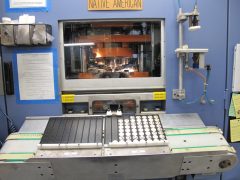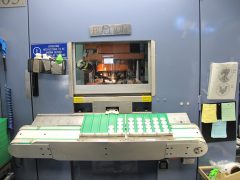Pressed penny machines… You gotta love them. Stick a penny into the slot, pick your design, start cranking, crank some more and then a little more. Eventually, out pops your flattened souvenir.

The mechanics are kind of similar with presses at the U.S. Mint at San Francisco, but the scope of Mint presses are obviously quite different and blazingly fast.
How fast? The SF Mint on average can produce about 200,000 collectible proof coins per day. More than 20.1 million were struck there last year alone.
In the mechanics, a blank slides into position flat side down so it can get squeezed between two vertically placed dies. These dies bear negative images of the heads and tails side of a coin. When the press applies some 90 tons of pressure between them, the blank flows like putty and accepts their designs. The blank doesn’t flatten like a penny in a souvenir machine as a surrounding collar restrains its expansion. That collar also creates a coin’s reeded edge or imparts the edge-incused lettering on Native American $1 Coins and Presidential $1 Coins.
If the terms "blanks" and "dies" are confusing or you’d like to see how they are prepared at the San Francisco Mint, check out the linked articles in the far right column. They are listed third and fourth under the series of articles about my visit at the SF Mint.
This fifth article describes how the San Francisco Mint turns blanks into coins. I really enjoyed this part of the tour. The SF Mint not only strikes proof coins for collectors but also millions of bullion American Silver Eagles each year. Seeing them produced and stacked by the thousands was something else.
Producing Coins at the U.S. Mint at San Francisco
In a large L-shaped area that San Francisco Mint employees call the Coining Press Room, there are nearly 20 presses lined up against walls. But before blanks get to them, they first receive some special attention. Though they have already been through the Treatment Room, the blanks are manually washed, dried and buffed. That’s quite an undertaking with the millions of proofs minted each year.
Washing and Drying Rooms for Coin Blanks





Die Vault
Every coin die, whether new or old, comes from and goes back into the die vault for storage and security.


Installing Coin Dies
Specially designed tooling kits are used to house dies which then fit inside coin presses.


Proof Native American $1 Coins and proof Presidential $1 Coins receive their edge lettering from a three-segment collar. Each segment bears a unique part of the edge inscription in raised letters. These segments are custom designed with slots so they cannot accidentally get placed into the die housing out of order and create coin errors.

In a coin press, the obverse Presidential $1 Coin die in its housing shown above behaves more like an anvil. The reverse die, shown and assembled in the die housing kit below, acts more like the hammer that pounds the anvil.



Coin Press Feeding
Prepared blanks are manually fed into loading magazines. The press feeding system takes a blank from a magazine to strike and produce one coin at a time.

Clicking on the photo below shows how the blanks look right before they’re made into coins.

SF Mint Laser Machine for Die Collar Engraving & Machine Shop
Jumping out of the Coining Press Room for a second, this is a laser machine that does the engraving for the three-segmented die collars discussed earlier. It engraves the stars, letters and numbers for edge letter collars used on dollar coins.

Also worth noting and in an area of its own, the U.S. Mint at San Francisco has its own machine shop that is responsible for modifying production tooling, process improvement support and design and engineering improvements.

Coin Presses at San Francisco Mint
Returning to the Coining Press Room, the following several photos show some of the SF Mint presses and their internal components.


If you look closely at the photos directly above and below, you’ll notice the reverse die at top center and the obverse die at bottom center.

Coins getting pressed at the U.S. Mint at San Francisco don’t shoot out into bins. They instead slide into custom coins trays to preserve their condition.
 |
 |

Pressed Coins Ready for Packaging
Finally, here are finished coins. These are really something to see in person.



With trays of proof coins readied, they will move to the packaging room for automatic placement into plastic lenses to create proof sets.
Upcoming Article About the U.S. Mint at San Francisco
Please return Wednesday, April 24, for the next article in a several part series describing my visit to the U.S. Mint at San Francisco. We’ll take a walk though the automated Packaging Rooms responsible for placing coins into lenses and boxing proof sets up for shipping. We’ll also see some of the quality assurance equipment and staff.

Article Series About U.S. Mint at San Francisco
- First Article: Discovering the U.S. Mint at SF
- Second Article: Under the U.S. Mint at SF
- Third Article: SF Mint, Preparing Coin Blanks
- Fourth Article: SF Mint, Preparing Coin Dies
- Fifth Article: Above





